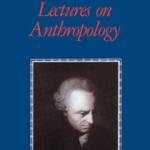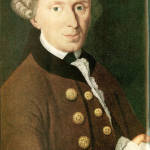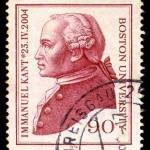
According to Ernst Cassirer, Immanuel Kant was “the man who introduced anthropology as a branch of study in German universities.”[1] And anthropologist W. E. Mühlmann calls Kant “the founder of the modern concept of race.”[2]
All humans are members of the same species, Kant argues, since members of the different races are capable of interbreeding. Nonetheless, there are important sub-divisions — Kant believes there are four main races: white, copper-red, black, and olive-yellow. Yet within the races there are distinctive characteristics of various nationalities — e.g., French, English, German, Italian, and so on. Kant hypothesizes about the source of these differences: “it is here a question of innate, natural character which has, so to speak, its seat in the composition of the human blood.”[3]
Spaniards, for example, must be of mixed blood: “as shown by bull-fights, his character is cruel, which is proved by the auto-da-fé of former times and this shows that his origin lies in part outside of Europe.”[4]
Further afield from Europe, Kant’s method becomes increasingly speculative, as he never left the Königsberg area his whole life. A sample hypothesis about Negroes:

“We know now, for example, that human blood turns black (as is to be seen in blood coagulum) when it is overloaded with phlogiston. Now the strong body odor of the Negroes, not be avoided by any degree of cleanliness, gives reason to suppose that their skin absorbs a very large amount of phlogiston from the blood, and that nature must so have designed this skin that in them the blood can dephlogisticate [sic] itself through the skin to a far greater degree than is the case with us in whom the latter function is mostly performed by the lungs.”[5]
Turning to breeding policy in particular: despite the fact that Kant believes we’re all members of the same species, he opposes reproduction across racial lines:
“The mingling of stocks (due to great conquests), little by little erodes the character and it is not good for the human race in spite of any so-called philanthropy.”[6]
That general proposition was applied by Kant in a letter that he wrote to the governor of Mexico. The Spanish Crown was encouraging a policy of interbreeding and had ordered the Mexican governor to comply. The governor had, however, opposed the order, and Kant wrote this in congratulations:

“[Of the idea that] nature would develop new and better races of produce them through the commingling of two races there is little ground for hope in as much as nature has long since exhausted the forms appropriate to soil and climate, whilst cross-breeding (for example of the American with the European or of these with the Negro) has debased the good without raising proportionately the level of the worse — hence the governor of Mexico wisely rejected the order of the Spanish Court to encourage interbreeding.”[7]
Kant’s account of race also includes the assumption that human perfection can be achieved only by the white race and that the others will become extinct. For details, see Wulf D. Hund’s “‘It must come from Europe’ The Racisms of Immanuel Kant,” which begins and ends with this disturbing quotation from Kant:
“All races will become exterminated …, except for the whites.”[8]
(All of which — combined with Kant’s views on women, Jews, war, education (here and here), and reason — raises the question: Should Kant really be categorized as an Enlightenment liberal?)

Sources:
[1] Cassirer quoted here. [2] Mühlmann, quoted in Léon Poliakov, The Aryan Myth: A History of Racist and Nationalist Ideas in Europe (Meridien, 1977), p. 171. A more recent edition. [3] Kant, in Poliakov, p. 171. [4] Kant, in Poliakov, p. 172. [5] Kant, quoted in John Greene, “Some Early Speculations on the Origin of Human Races,” American Anthropologist (1954), 56:31-41, p. 6. Greene gives the source as Kant’s 1785 Bestimmung des Begriffs einer Menschenrace, Gesammelte Schriften (Berlin, 1912), 8: 89-107. [6] Kant, in Poliakov, p. 172. [7] Kant, in Poliakov, p. 353. [8] Wulf D. Hund, “‘It must come from Europe’ The Racisms of Immanuel Kant,” 2011, p. 91.
Related: Kant’s foundational Critique of Pure Reason, in the Philosophers, Explained series:
The Kant on women link is broken
I’m curious: do you know why Spain encouraged the policy of interbreeding in Mexico? What were their reasons for it?
Thanks, Lorenzo. Fixed now.
Kant is as much as part of the Enlightenment as any other thinker of those ages. Because of the local (from feudal?) nature of Europe and England’s island status, not too much research on other peoples was done. The French, Spanish and English explored the New World whilst the Germanies were rent by the 30 Years War, that set back their “nationalization” by 2 centuries. The French and Spanish were willing to wive the nearest Indian whereas the English believed one could not interbreed with the locals and remain as ruler. We’ve all heard the expression, “Gone native.”
Not all this “racist” (a loaded term today, used in Liberal smears regularly) commentary was hateful or prejudiced. Diderot’s story of Bougainville or, even the Jungle Books of Kipling. It is one thing to admire another race/culture, another to marry into it. As my mother instructed me “You don’t just marry the girl, you marry the family.” Statistically, most “interracial” unions fail — almost 90% . Often the woman is a “trophy bride” or the couple care more about attracting attention than each other.
I like to say, “One human race, many human families.” The earliest genealogy we have of mankind is the Book of Genesis, which specifies the progeny of Noah (though not of the Ark females). Japeth, the forefather of the Europeans, has a name which means “explorer,” Shem, ancestor of the Semites, “religious,” but Ham, from whom most colored fokes means “swarthy, sunburnt.” Adam, the reputed father of mankind itself, mean “the man” but also “clay”, suggesting Adam was a true Beach Boy sans surfboard. If you study the grandchildren of Noah they all lead to major families of mankind. Asiatics are generally thought to be the result of Japethic and Semitic coupling.
The single most homogeneous people with a three thousand year history are the Jews, the descendants of Abraham, but he also spawned the Arabs through a union with his wife’s maid, Hagar, in their son Ishmael. Indeed, if you consider, one must arrive back at the first two parents of any clan. The Jews have for political and religious reasons little intermarrying with the Gentiles/nations. To be a Jew necessitates being a descendant of Jacob (named, Israel). Because of the destruction of Temple records no living Jew can prove his ancestry. Rabbinical law has settled on having a Jewish mother, from which all the children are “Jewish.”
So, does inbreeding not have a significance? Is marrying a person of “another race” desirable? Can we not get the worst of both? Do the Jews not owe their singularity, success, and vitality to their having intermarried (though not to brothers or sisters, etc, but cousins, OK)? Ask any cattle or horse breeder, and you’ll find inbreeding desirable. The freaks of the process — shall we say, in the Appalachians ? — are the result of incest. A decision to stay within one’s family need not be hateful but common sensible. Moreover, many cultures do not welcome new blood. There is usually nothing to be gained from miscegenation, but that does not mean people who love each other, no matter their backgrounds, cannot be wed.
In his seminal ‘Guns, Germs, and Steel’ Jared Diamond identifies biological, environmental and geographic factors of fundamental importance accounting for the differing levels of development among societies – such as the vastly greater panoply of domesticable plants and animals available to Eurasians of the fertile crescent, which allowed for the maintenance of large demographics of non-food producing specialists, in turn facilitating those societies’ advancement; the proximity of the large range of livestock facilitating development of an enormous immunological advantage over, say, the populations of the Americas; the east-west axis of the Eurasian-North African landmass facilitating the transfer of ideas and technologies more easily than the more climatically striated north-south axis of Africa and the Americas.
He takes pains to stress that this is not determinism or an attempt to refute free will, but simply an identification of factors that led one society to obtain an enormous advantage over another, in much the same way that placing a child in a poor and violent ghetto environment is less likely to produce desirable results than placing him in an affluent and educated one.
Diamond appears to sense and make way for the fact that at some point the issue of a society’s core ideas and values outweighs these factors, shaping its responses to the challenges and predicaments that confront it.
For example, one revolt against oppression led to Thomas Jefferson and the United States of America; another led to Josef Stalin and the Union of Soviet Socialist Republics; yet another led to the Ayatollah Ruhollah Khomeini and the Islamic Republic of Iran. All three had a reasonable to rich resource base yet produced dramatically different results in accordance with their dominant ideologies and value systems.
A cursory look at history ought to be humbling to Aryan racial supremacists. While the “master race” was stagnating in its Dark Ages the Middle and Far East were the most advanced civilizations on earth.
Centuries ago the ideas and technologies the West needed lay in the East: in the decaying Eastern Roman or Byzantine Empire (which while an oppressive theocracy still possessed much of the Hellenic written corpus) and the then far more advanced Islamic world (which also served as a conduit for ideas and technologies from the Far East e.g. Chinese paper, printing, porcelain, the compass and gun powder; Persian administrative methods, medicine, irrigation, architecture and decorative arts; Indian metallurgy, shipbuilding, astronomy and mathematics including the Hindu-Arabic numerals and trigonometric functions – it is difficult to be precise about the origins of many of these). Their importation into the West, one of history’s largest such transfers, via points of contact in the Levant, Venice, Genoa, Sicily, Moorish Spain and elsewhere transformed European society, leading to the High Middle Ages, Renaissance, Enlightenment, Industrial Revolution and Modern Era. It is fair to say that but for the Middle and Far East the West would not remotely be what it is today.
One might argue with Mr. Fox above that he selects a low point in the “Aryan” history. As there is no agreement of who is “Aryan” I would limit this term to European, and assert that “Aryan” civilization begins with the Greeks. From Greece to Rome and thence to things medieval and renaissance-ish and Elizabethan and Enlightened and…
Virtually all our culture, science, philosophy, music, art, mechanics…comes from European roots. That Chinese emperors had exquisite teacups and floors of porcelain and shot off fireworks, or that Hindoos invented some mathematics, and Arabs were cool at time, and Egyptians had nice tombs — these are peppercorns on the great feast of European genius. We tend to ascribe culture to civilizations based on their ruins, but Greek philosophy, for example, still lives today, and its concomitants in art and architecture (unfortunately, we know little about their music). Yet Herodotus wrote, “compared to the Egyptians in mathematics, we are but children”, a phrase which requires some thought.
There is one human race, and brilliant men are likely to pop up anywhere, so, in one respect, we are in a statistical context. In a somewhat dour mood I ask, “What has sub-Saharan Africa given to the world?” and can only think, the banjo.
People love to rave (hypocritically) “Oh, look at the wonderful progress in China!” but remember, without German machines for mass-production, that ant-hill would not have true economic advantage. “Isn’t it marvelous, this new Minolta camera, look how the Japanese have automated all the controls…” but the chip to sophisticate this device was invented in New Jersey. Please tell me one true invention (not discovery) from China or Africa or the Aztecs or the Inuits…puh-leeze. This being said, we have a hopefully better understanding of Kipling’s much misunderstood, “Take up the white man’s burden…”
Boswell enthused to Dr. Johnson, “Sir, are the Chinese not wonderful people?” Dr. Johnson : “They excel at pottery.” Bozzy : “Indeed, Sir, they excel at many things.” Dr. J : “Yes, sir, at pottery. They have not learned to produce that sine qua non of civilized people, an alphabet, but still paint pictures…” [my recall] It’s in the LIFE.
There is, however, the argument that other cultures (races, families, tribes, call ’em what you will) will in the future produce wonders. A famous nuclear physicist believes the “next Einstein will come from Africa.”
I doubt it.
Obvious ad hominem attack on Kant is obvious.
Not just the Greeks. The greatest ancient contribution to astronomy came from Ptolemy in Alexandria, Egypt. Sure, Greek culture had influenced Egyptians of the time, but they were African, not European.